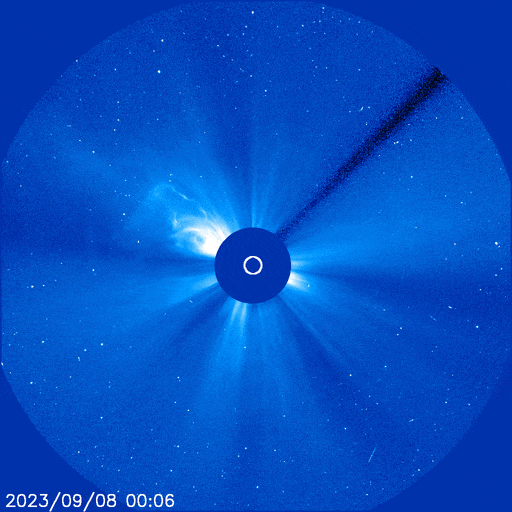Sept. 27, 2023: (Spaceweather.com) When Vincent van Gogh painted “The Starry Night” in 1889, little did he know he was working at the forefront of 21st century astrophysics. A paper recently published in Nature Communications reveals that the same kind of waves pictured in the famous painting can cause geomagnetic storms on Earth.

Above: Vincent van Gogh’s ‘Starry Night’, which he painted in 1889: more
Physicists call them “Kelvin Helmholtz waves.” They ripple into existence when streams of gas flow past each other at different velocities. Van Gogh saw them in high clouds outside the window of his asylum in Saint-Rémy, France. They also form in space where the solar wind flows around Earth’s magnetic field.
“We have found Kelvin-Helmholtz waves rippling down the flanks of Earth’s magnetosphere,” says Shiva Kavosi of Embry–Riddle Aeronautical University, lead author of the Nature paper. “NASA spacecraft are surfing the waves, and directly measuring their properties.”
This was first suspected in the 1950s by theoreticians who made mathematical models of solar wind hitting Earth’s magnetic field. However, until recently it was just an idea; there was no proof the waves existed. When Kavosi’s team looked at data collected by NASA’s THEMIS and MMS spacecraft since 2007, they saw clear evidence of Kelvin Helmholtz instabilities.
“The waves are huge,” says Kavosi. “They are 2 to 6 Earth radii in wavelength and as much as 4 Earth radii in amplitude.”

This computer model shows van Gogh waves moving down the flank of Earth’s magnetosphere. Credit: Shiva Kasovi. [full-sized animation]
Imagine a wave taller than Earth curling over and breaking. That’s exactly what happens. Kelvin-Helmholtz waves naturally break onto Earth’s magnetic field, propelling energetic particles deep into the magnetosphere. This revs up Earth’s radiation belts, triggering geomagnetic storms and auroras.
A key finding of Kavosi’s paper is that the waves prefer equinoxes. They appear 3 times more frequently around the start of spring and fall than summer and winter. Researchers have long known that geomagnetic activity is highest around equinoxes. Kelvin-Helmholtz wave activity could be one reason why.
Our planet’s seasonal dependence of geomagnetic activity has always been a bit of a puzzle. After all, the sun doesn’t know when it’s autumn on Earth. One idea holds that, around the time of the equinoxes, Earth’s magnetic field links to the sun’s because of the tilt of Earth’s magnetic poles. This is called the Russell-McPherron effect after the researchers who first described it in 1973. Kavosi’s research shows that Kelvin-Helmholtz waves might be important, too.
Northern autumn has just begun, which means Kelvin Helmholtz waves are rippling around our planet, stirring up “Starry Night” auroras. Happy autumn!



